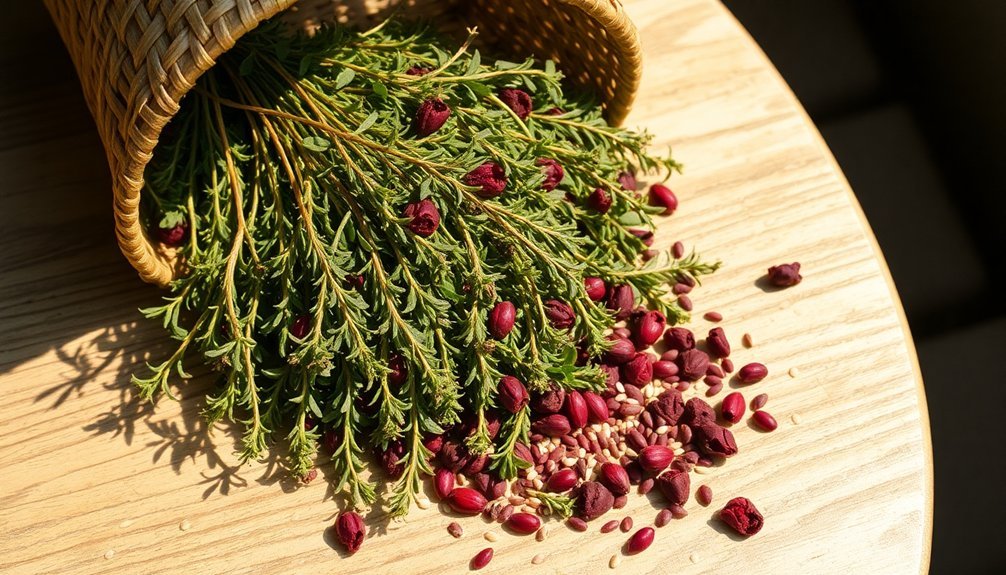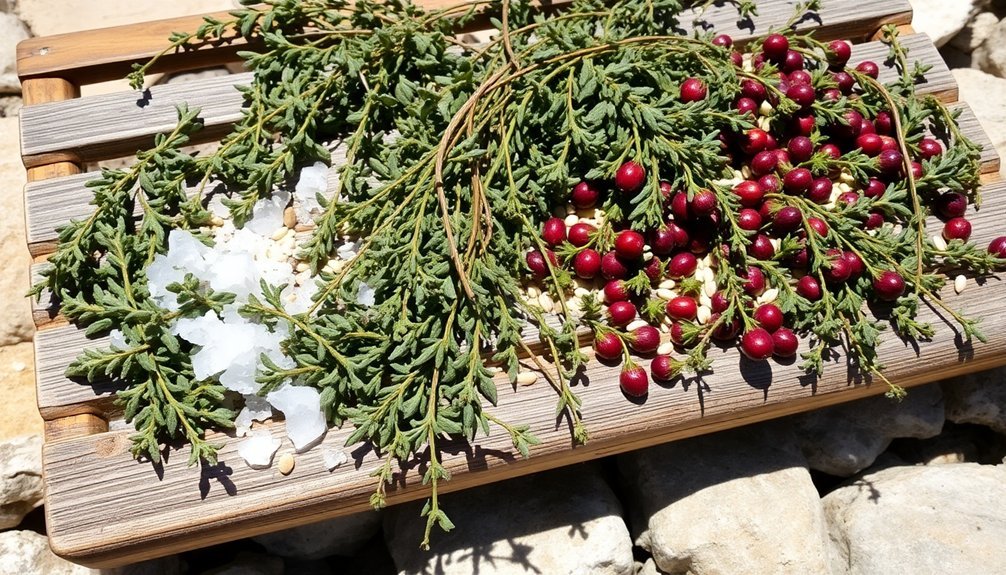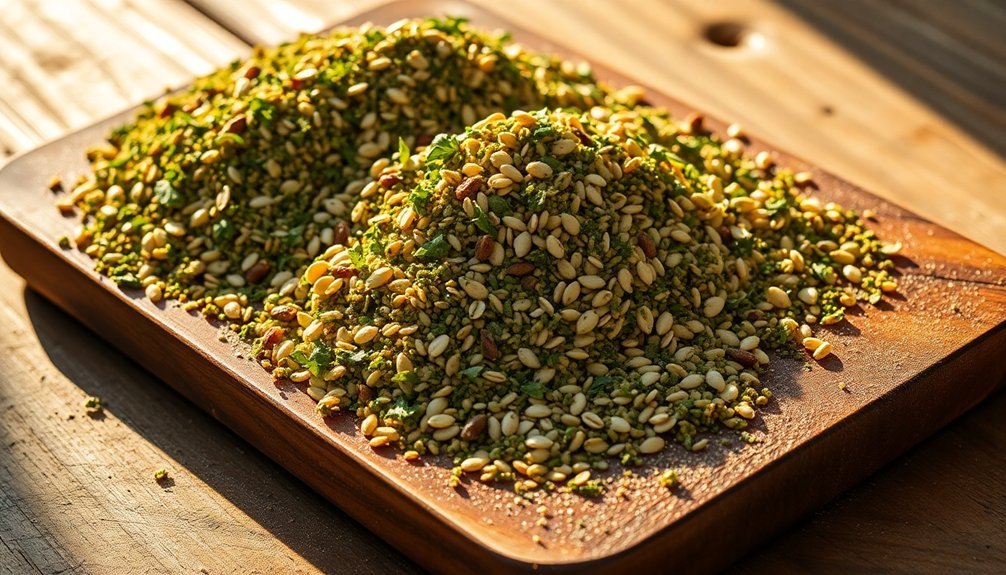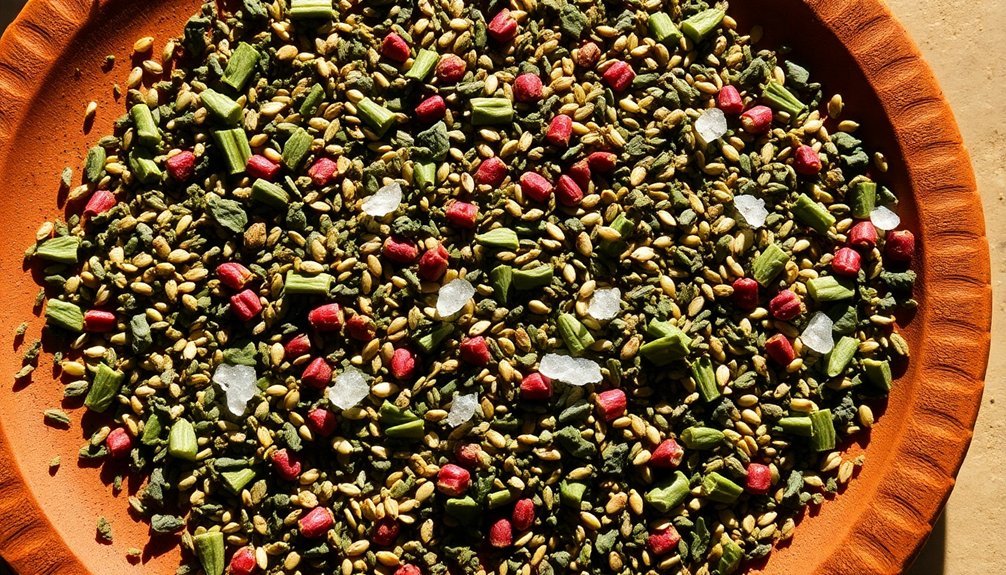Za'atar's ancient roots trace back to Tutankhamun's tomb, where dried herbs similar to today's blend were discovered. You'll find this aromatic Mediterranean spice mix combines sun-dried wild herbs like Syrian oregano with toasted sesame seeds and sumac. Traditional solar drying takes place over several days, with fresh leaves carefully laid out in single layers and rotated for even exposure. The versatile blend enhances everything from flatbreads to grilled meats, while proper storage in airtight glass containers maintains its vibrant flavors for up to two years. There's much more to uncover about this time-honored spice blend's harvesting, preparation, and culinary applications.
Origins of Sun-Dried Za'atar Spices

The legacy of za'atar stretches back through millennia of Middle Eastern history.
You'll find evidence of this aromatic blend's ancient origins in Tutankhamun's tomb, where archaeologists discovered dried Thymbra spicata, a key za'atar component.
In the first century CE, Pliny the Elder documented a similar herb called maron, used by Parthian royalty.
Jewish scholars, including Maimonides and Ibn Ezra, connected the biblical herb "ezov" (hyssop) to what we now know as za'atar.
This connection isn't surprising, as the wild Syrian oregano that forms za'atar's base was highly valued throughout the ancient Mediterranean.
Notable healers like Hippocrates and Maimonides prescribed za'atar as a remedy for bronchitis and colds, cementing its place in both culinary and medicinal traditions.
The sacred spice blend became an integral part of Middle Eastern cuisine and remains popular across various cultures to this day.
Traditional Harvesting and Drying Methods
While modern spice production relies heavily on machinery, traditional za'atar harvesting remains a hands-on process that begins in early summer when the plants reach peak flavor.
You'll find harvesters carefully selecting fresh leaves, either beating the plants with sticks or manually detaching them from stems. After multiple washings to remove debris, they'll sort through the leaves meticulously. The Shouf mountains region is particularly renowned for its wild za'atar harvesting traditions.
The drying process is equally precise. You won't see leaves laid out in direct sunlight; instead, they're placed in shaded areas for three days.
Once initially dried, they're bundled and moved indoors for another 7-10 days. From there, you'll need to sift the dried leaves through both wide and fine sieves, removing unwanted stalks and sorting them by size before grinding them into the powder you'll use in your final blend.
Solar Preparation Techniques

Modern solar preparation techniques build upon these time-tested traditional methods, offering you more efficient ways to harness the sun's energy for drying za'atar leaves.
When you're preparing your za'atar for solar drying, select fresh, green leaves from the top of the plant and carefully remove any stems or woody parts. Lay them on a white sheet in a single layer, ensuring proper air circulation to prevent moisture buildup. This ancient practice helps preserve the immune-boosting properties found naturally in za'atar.
- Cover your drying leaves with mesh to protect from insects
- Rotate leaves periodically for even sun exposure
- Bring leaves indoors at night to avoid dew
- Check regularly until leaves become crispy and brittle
- Store in airtight containers away from light
Once dried, you'll grind these leaves and combine them with perfectly toasted sesame seeds to create your authentic za'atar blend.
Regional Mediterranean Flavor Profiles
Throughout Mediterranean coastal regions, distinct flavor profiles have evolved through centuries of cultural exchange and local ingredient availability.
You'll find Italy's rich, savory dishes highlighting tomato-based sauces with herbs like basil and oregano, while Greece emphasizes tangy flavors from lemon, feta, and yogurt. Local chefs often incorporate fresh seasonal produce to create authentic Mediterranean flavors.
Spain's cuisine combines sweet and savory elements, relying heavily on olive oil, garlic, and saffron.
In the Eastern Mediterranean, you'll encounter earthy za'atar blends and tart sumac, creating complex flavor layers in dishes like flatbreads and grilled meats.
North African Mediterranean cooking offers aromatic profiles, where you'll taste warm spices like cinnamon, ginger, and turmeric in tagines and couscous dishes.
Each region's unique spice combinations reflect its heritage while maintaining a connection to shared Mediterranean culinary traditions.
Culinary Uses and Applications

You'll find za'atar's versatility extends from traditional Middle Eastern flatbreads and marinades to quick weeknight meals like seasoned sweet potato fries and grilled meats.
Whether you're sprinkling it on hummus as a garnish or incorporating it into stuffing for holiday turkey, this herb blend adds depth and complexity to both simple and elaborate dishes.
Modern applications have expanded beyond traditional uses, with za'atar now appearing in creative fusion dishes, savory cookies, and specialty dips like sun-dried tomato tahini.
Traditional Middle Eastern Dishes
Za'atar's versatility shines brightest in traditional Middle Eastern cuisine, where it's liberally used across a vast array of dishes from breakfast to dinner.
You'll find this aromatic spice blend enhancing the flavors of grilled meats like shawarma and shish kebabs, adding depth to vegetable-based dishes such as fattoush and tabbouleh, and bringing complexity to appetizers like hummus and baba ghanoush.
- Sprinkle it over freshly baked pita bread with olive oil
- Use it as a marinade for kebabs and grilled meats
- Mix it into salads like fattoush for an authentic touch
- Blend it into dips such as hummus or baba ghanoush
- Season rice dishes and pilafs with it for added complexity
The spice blend particularly complements dishes featuring roasted vegetables, grilled meats, and grain-based preparations that are staples of Middle Eastern cooking.
Quick Everyday Meal Ideas
Beyond its traditional Middle Eastern roots, incorporating za'atar into everyday cooking opens up a world of quick and creative meal possibilities.
You can transform simple avocado toast into a Mediterranean delight by sprinkling za'atar on top, or elevate your morning eggs with a dash of this aromatic blend.
For lunch, toss it into salads with roasted vegetables and lentils, or use it to season quick-roasted Brussels sprouts.
When dinner time arrives, you'll find za'atar works wonders as a rub for grilled meats or roasted salmon.
It's also perfect for jazzing up simple pasta dishes with chickpeas and vegetables.
For snacks, sprinkle it over hummus or mix it with olive oil for a quick bread dipping sauce.
You can even add it to nuts for a savory twist.
Creative Modern Applications
While traditional Middle Eastern cuisine remains za'atar's primary domain, innovative chefs and home cooks worldwide have embraced this versatile blend in surprising new ways.
You'll find za'atar elevating everyday Western dishes like avocado toast and popcorn, while also making appearances in fusion cuisine across continents. It's particularly effective when paired with sun-dried tomatoes for fish dishes or incorporated into holiday stuffings.
Here are some creative ways to use za'atar in modern cooking:
- Mix with olive oil to create a flavor-packed spread for sandwiches
- Sprinkle over scrambled eggs or morning bagels
- Add to homemade pizza or focaccia before baking
- Use as a dry rub for grilled meats and vegetables
- Combine with breadcrumbs for a crispy coating on chicken or fish
Preserving Your Solar-Dried Blend
To keep your sun-dried za'atar at its peak flavor, you'll need an airtight glass or ceramic container that completely seals out moisture and air.
Your container choice makes a significant difference in preserving the blend's potency, with properly sealed vessels helping maintain those essential volatile oils and aromatics.
When you're not using your za'atar, make sure the lid is tightly secured to protect against humidity and extend its shelf life up to two years.
Storage Container Selection
Selecting the right storage container for your sun-dried za'atar can make the difference between preserving its vibrant flavors for months or losing them within weeks.
Glass jars and ceramic containers with tight-fitting lids are your best options, as they're non-reactive and protect against moisture. You'll want to avoid metal containers that can affect flavor and plastic ones that might let in air.
Here's what to look for in your storage container:
- Airtight seal to keep moisture and air out
- Dark or opaque material to shield from sunlight
- Non-porous surface to maintain freshness
- Appropriate size to minimize excess air space
- Clear labeling area to track storage dates
Remember to choose containers that match your za'atar quantity and intended storage duration.
If you're storing multiple batches, smaller containers work better than one large one.
Longevity Through Proper Sealing
Once you've sun-dried and properly stored your za'atar blend, maintaining its freshness depends heavily on proper sealing techniques.
To maximize your blend's 2-3 year shelf life, verify your container has an airtight seal that prevents moisture and air from degrading the spices.
You'll need to check your za'atar regularly for signs that it's losing its potency.
Watch for changes in color, clumping, or loss of its signature aroma. If you notice any of these indicators, it's time to make a fresh batch.
For best results, keep your sealed container in a cool, dark pantry away from heat sources like your stove.
If you live in a humid climate, consider storing your za'atar in the refrigerator to extend its life and maintain its vibrant flavors longer.
Frequently Asked Questions
Can Za'atar Blend Trigger Allergic Reactions in Sesame-Sensitive Individuals?
Yes, if you're allergic to sesame, you'll need to avoid za'atar since it contains toasted sesame seeds. The blend can trigger reactions ranging from mild symptoms to severe anaphylaxis in sensitive individuals.
How Long Does Homemade Sun-Dried Za'atar Maintain Its Peak Flavor?
Your homemade za'atar will maintain its peak flavor for 3-6 months when stored properly. You'll get the best taste if you keep it in an airtight container away from heat and light.
What's the Difference Between Wild and Cultivated Za'atar Herbs?
You'll find wild za'atar has a more complex, robust flavor and stronger medicinal properties than cultivated za'atar. While cultivated varieties are more accessible and consistent, they typically lack the intense depth of wild varieties.
Can Pregnant Women Safely Consume Sun-Dried Za'atar Blends?
You can safely consume za'atar while pregnant, but use it in moderation. It's best to check with your doctor first, especially if you're sensitive to herbs or have allergies to sesame seeds.
Are There Kosher and Halal Certified Versions of Za'atar Available?
Yes, you'll find both kosher and halal-certified za'atar options. LiOR Za'atar offers both certifications, while other brands like Woodland Foods and Teeny Tiny Spice Company provide kosher-certified versions for your dietary needs.
In Summary
You'll find that sun-dried za'atar connects you to centuries of Mediterranean culinary tradition. By following proper solar drying techniques and understanding regional flavor profiles, you're able to create authentic blends at home. Whether you're sprinkling it on flatbreads, mixing it into dips, or using it as a finishing seasoning, your homemade sun-dried za'atar will bring vibrant, aromatic flavors to your dishes.





Leave a Reply